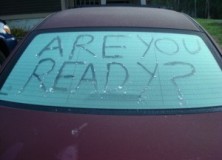Before the weather gets too much colder and the snow begins to fly, now is the time to prepare your car for the winter.
When it’s freezing outside, a breakdown could become far worse than a mere inconvenience. To help prevent car trouble, the Federal Emergency Management Agency suggests you or your mechanic follow these 12 checkpoints to winterize your vehicle:
- Engine antifreeze. Check levels and add more, if necessary.
- Battery. When starting the car, pay attention to see if it starts without hesitation. Check positive and negative terminals for corrosion and powdery buildup. The terminals may need to be cleaned, or it could be time to replace the battery.
- Brakes. Check for excessive wear and add brake fluid, if necessary.
- Exhaust system. Repair or replace any leaks or crimped pipes.
- Fuel and air filters. Replace them according to your vehicle’s maintenance schedule.
- Fuel. Always keep plenty of gas in the tank, both to avoid running out and to prevent fuel lines from freezing.
- Heater and defroster. Test both systems to make sure they blow warm air. Testing an electric defroster (found in many rear windshields) might require the help of a mechanic, or you could simply wait for the next time the windshield fogs up.
- Lights and flashing hazard lights. Check and replace any that are dim, fogged or not working.
- Oil. Check the level and add oil, if necessary. You can find the recommended level in your owner’s manual.
- Thermostat. Watch the temperature gauge on your dashboard; it should stay near the center line under normal driving conditions. If the needle goes much higher or lower, it could be a sign of a faulty thermostat, which could lead to engine trouble.
- Windshield wiper equipment. Repair any problems and maintain the proper level of washer fluid. Fill the windshield washer reservoir with a solution for cold weather, which can be purchased at most auto parts stores.
- Tires. Replace them if they are excessively worn. All-weather radials are usually adequate for winter conditions, though some especially inclement regions have laws requiring vehicles to be equipped with chains or snow tires.
Use Caution in the Cold
During the winter months, poor road conditions, decreased visibility and the stress that cold weather puts on your car can combine to create a treacherous driving environment. Before you head into the cold, heed these tips for safe winter driving:
- Keep an ice scraper and a small broom in your car to remove snow and ice from the windshield and windows. Don’t use the scraper or broom on your car’s painted surfaces.
- If you see snow, take it slow. The same goes for ice, fog and other forms of precipitation. Driving slowly makes it easier to maneuver and stop when necessary.
- Accelerate slowly, increase following distances and approach potentially icy bridges and overpasses with extra caution.
- Brake earlier than is usually necessary and apply the brakes gently to gauge their traction.
- Keep a small container of cat litter or sand in your car. It may get you unstuck from a slippery mishap.
- Be prepared in case you get stranded. Store the number for any roadside assistance service you are a member with in your smartphone. Also, carry emergency supplies, such as blankets, nonperishable food, water, a flashlight and road flares.
Disclaimer: On January 4, 2016, the owner of WestEastonPA.com began serving on the West Easton Council following an election. Postings and all content found on this website are the opinions of Matthew A. Dees and may not necessarily represent the opinion of the governing body for The Borough of West Easton.







